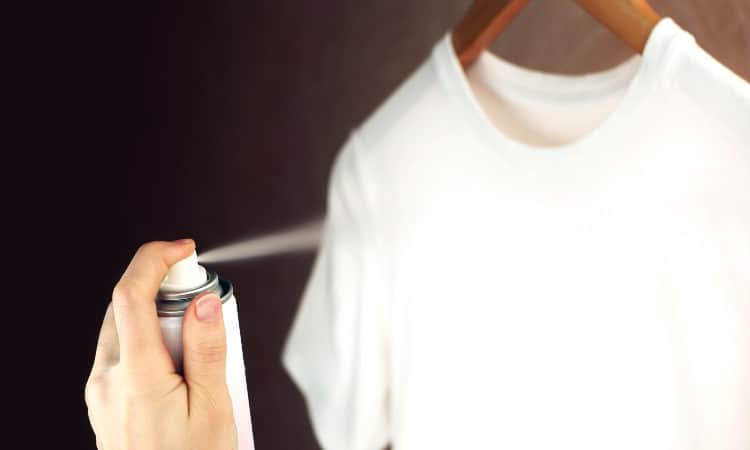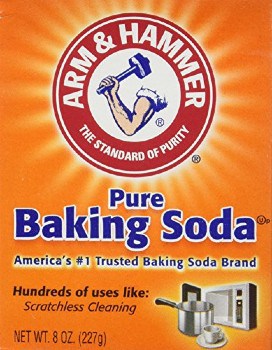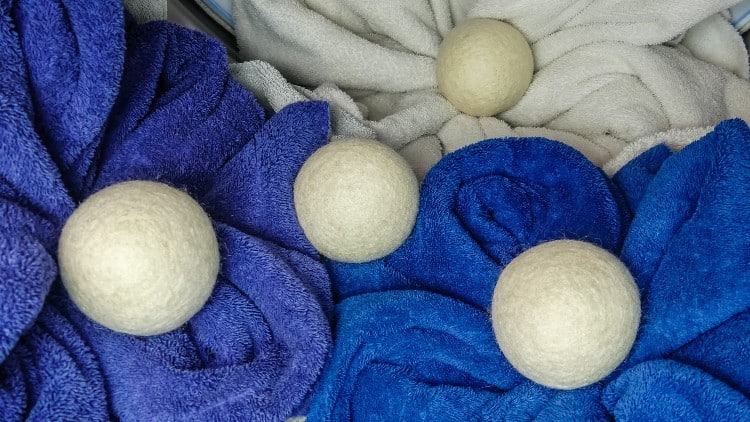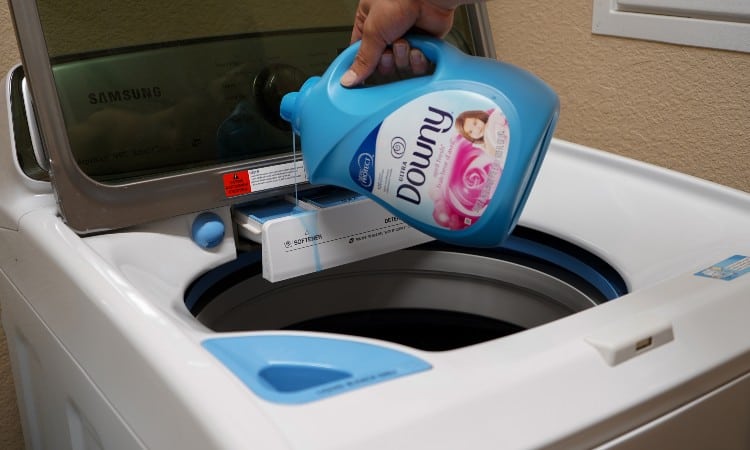My cat is annoyed with me. I hadn’t realized my clothes were full of static. When I bent down to pet her, she got such a jolt! Now I feel guilty and have a very important question. How do you get rid of static in clothes?
Static can be removed from clothing with a metal clothes hanger. Rub it up and down the garment to eliminate the static charge. As static loves dry conditions, add moisture to the garment by steaming it. Alternatively, spray the garment with an anti-static spray or use hairspray.
In this article, you’ll learn what causes static to build up in clothes. You’ll discover how to get rid of it simply and effectively. In addition, you’ll find out how to prevent static in the first place.

What Causes Static in Clothes?
Static is that annoying burst of energy that zaps you when you are least expecting it. Whether it’s because you touched your cat, your metal desk, or even when you pass an object to someone else, it is infuriating and can also hurt.
It has a funny side too. You can create static electricity by rubbing a balloon against your hair for a minute. When you put the balloon against a wall, it will stick there. Better still, your hair will stand to attention, making you look like a mad professor.
Caused by a mismatch in the number of positive and negatively charged electrons, static happens when two solid items are moved against each other. This can be your clothing rubbing as you wear it or your shoes when you walk across a nylon carpet.
To create static, one of the surfaces must have weak bonds keeping their electrons in place. These bonds break when two surfaces rub together, enabling the weaker side to release electrons and become positive. Now you have free-falling electrons with nowhere to go.
That’s where side number two comes in. Electrons don’t like floating about by themselves. So, the next stage in the static-making process comes into being. The second side starts to pick them up.
It has to have vacancies or empty spaces to do that. A bit like a motel on a busy highway. The more electrons released by, the weaker side, the more rooms are filled at the Inn. When all the rooms are occupied and there is no more space, the Inn becomes overfull and feels slightly negative.
Now you have two surfaces with an unequal amount of positive and negative electrons. You’ll know from science experiments at school that opposites attract. Well, the flip side of that rule is same sides repel. So, when your two garments or your garment and your skin come into contact, all the positive electrons try to get as far away as possible from each other, as do the negative ones.
It’s this movement of electrons that causes the electrostatic charge in your clothing. Creating a sudden flash and bang, the charge is expelled when you touch something grounded, like a light switch or your cat.
Although static can be created by solid objects that allow the free movement of electrons, it can also be caused by other factors. Your dryer is a common culprit for mixing up those pesky electrons.
Then there is the fabric your clothes are made from. Synthetic materials are more susceptible to static bursts. Even your skin can increase your chances of suffering from static cling or a sudden shock.
Static loves low humidity and dry environments. If you have dry skin and live in an area where the humidity levels are low, you are at a higher risk of getting zapped by your garments.
Even the time of year can alter your chances of suffering from static. While your favorite polycotton dress may behave itself in June, it’s now November and it’s got the worse case of static cling you’ve seen in months.
It can leave you wondering what went wrong. Well, the chances are, things have taken a downward turn on the temperature dial. You’re most likely wearing your dress with tights.
Fall and winter are the seasons when you wear layers to keep warm. Those layers can be a mix of materials, both natural and synthetic. Wearing garments made from various fabrics can fill your life with winter wardrobe jolts.
Fabrics Most Likely to Suffer From Static

The fabrics most likely to suffer from static are synthetic. Although it’s not a phenomenon exclusive to synthetic fibers, it’s the artificial materials that take top billing as the main culprits.
When it comes to static, not all fabrics are created equal. Some are more prone to sending a quick jolt of electricity through your body than others. Let’s take a look at the contenders for the title of worst fabric for causing static.
Acrylic
Acrylic is a synthetic fiber that is used as an alternative to wool. You’ll find it in clothing, soft furnishings, and carpets. That’s not all. You can also find acrylic in false nails and plexiglass. This is because it’s essentially plastic.
Regardless of what acrylic is used for, all variations have one thing in common. An intense propensity for producing static. It’s one of the most prolific static producers on the planet.
Polyester
Polyester is another synthetic material that is plastic at heart. Although you can find polyester in your garments and home furnishings, you’ll also find it in your soda bottles.
In a similar way to acrylic, it’s the plastic nature of polyester that causes static build-up. Static just loves dry conditions. As a plastic, polyester is moisture-free and can provide static with the perfect home-from-home.
Rayon
Unlike the first two fabrics on this list, rayon isn’t fully synthetic. It isn’t fully natural, either. Made from wood pulp from plants like bamboo, rayon is treated with chemicals to soften it enough to use as a fabric. Because of that, rayon is classed as a hybrid or a semi-synthetic.
Its mixed heritage doesn’t reduce the risk of static, though. Even if it is only half a synthetic, it still ranks highly on the susceptibility to static scale.
Silk
Made from the cocoons of silkworms, silk is an animal-based natural fiber. It has the same look and feel as rayon. Rayon was introduced as a silk substitute. The two fabrics have something else in common, their tendency to create static.
When your silk blouse rubs against your acrylic cardigan, it can cause friction. As silk is dry, you have the perfect breeding ground for the build-up of static electricity.
One of the annoying things about silk is its ability to create static isn’t restricted to when you wear your garment. Silk will produce static even while it’s hanging in your closet.
Wool
Woolly sweaters and static go together like ham and eggs. Wear one for a while, pull it over your head, and you’ll see what I mean. Your hair will stand on end and you’ll hear the unmistakable crackle of static electricity.
This is partly due to wool’s generosity. Wool is conductive, which means the bonds on its electrons are loose. It goes through life happily, sharing its electrons with any surface it comes into contact with.
Another reason is the time of year you tend to wear wool. It’s a winter fabric. Winter, dry conditions, and an eagerness to release electrons, make wool one of the biggest culprits in the production of static.
How to Get Rid of Static in Clothes
It can be tempting to throw out your entire wardrobe to get rid of static in your clothes. Maybe it would be easier to ditch the lot and start again. Only this time, stick to fabrics like cotton and leather. Neither of those fabrics are known to produce static.
But that option could prove to be expensive. You’ll be pleased to know there are cheaper and less drastic ways of beating the dreaded fabric-zapping gremlin. Let’s take a look at them.
1. Aluminum Foil
You’ve probably got some of this sitting in your kitchen cupboard. Not only is aluminum foil great for ensuring your chicken is evenly roasted, but it’s also incredibly effective at neutralizing static.
You will need:
- One sheet of aluminum foil
- Dryer
Step 1
Rip off a sheet of aluminum foil from the roll. It doesn’t have to be too big. About 12 inches long should do. Then, scrunch it up into a ball.
Step 2
Throw the ball into your dryer with your wet laundry. Use your normal dryer settings. The aluminum ball will move inside the dryer, killing off the static.
2. Anti-static Sprays
 You can make your own or buy commercially made anti-static sprays. One such product is Sprayway Residue-Free Anti-Static Spray. You can use that one on wool and synthetics.
You can make your own or buy commercially made anti-static sprays. One such product is Sprayway Residue-Free Anti-Static Spray. You can use that one on wool and synthetics.
Making your own anti-static spray is simple. You can use water on its own or a mixture of water and fabric softener.
You will need:
- Spray bottle
- Cold water
- Fabric softener
Step 1
Put the water into your spray bottle. You can add fabric softener if you want a fresh scent to your garment. You’ll need 2 tablespoons of softener. Or you could use a couple of drops of your favorite essential oil.
Step 2
Give the bottle a shake to mix the softener in with the water. Then, all you need to do is spray your garment. Don’t overspray it, though. You want to get rid of static, not drench your clothes.
If you want to, you can use water on its own. Adding moisture to your garment is an effective way of combating static.
3. Baking Soda
 This static-busting solution eliminates the electric peril while the washing is still in the machine. Better still, it makes your laundry look brighter. A particularly good thing if you’re washing white clothing.
This static-busting solution eliminates the electric peril while the washing is still in the machine. Better still, it makes your laundry look brighter. A particularly good thing if you’re washing white clothing.
You will need:
- Baking soda
- Your usual laundry detergent
- Washing machine
Step 1
Put your laundry detergent in the washing machine as you would normally. Add ½ cup of baking soda. You can put this in the dispenser drawer with the detergent. If your machine doesn’t have a dispenser drawer, pour the baking soda over the top of the clothes when they are in the drum.
Step 2
Wash your clothes as you would normally. When the cycle has finished, remove the garments and dry them according to their care labels. You should find any trace of static has been eliminated.
4. Change Your Shoes
This solution is for when your carpet is causing the static problem. When you shuffle your feet across an acrylic or nylon carpet, it will create friction. Which in turn leads to static electricity. It’s not so much your feet that are the issue. It’s your shoes.
Not all shoes will cause static to build up. Their chances of doing so are dictated by the content of the soles. Rubber soles might be the go-to choice for avoiding shocks from mains power, but they are notorious static makers. To avoid the zap from your carpet, switch your shoes to ones with leather soles.
Leather isn’t prone to static. Another material that lacks a tendency to cause static is cotton. So swap your acrylic socks for a pair made from cotton fibers. Cotton socks and leather shoes are a recipe for static-free living.
5. Dryer Balls and Sheets
 These work in the same way as fabric softeners. Only you put dryer balls and sheets in the dryer, not the washing machine. It doesn’t matter if you use balls or sheets. Just don’t use both at the same time.
These work in the same way as fabric softeners. Only you put dryer balls and sheets in the dryer, not the washing machine. It doesn’t matter if you use balls or sheets. Just don’t use both at the same time.
Use dryer sheets if you want to add a fragrance and dispel static. Dryer balls are great for removing static when you can’t use a fabric softener.
You will need:
- Dryer balls or dryer sheets
- Dryer
Step 1
Check your wet washing to make sure you can dry it in a dryer. Then, check to see if you can use a fabric softener with it. If you can, add one dryer sheet to the drum. If the fabric has a special finish that a fabric softener would destroy, use dryer balls. You should add at least 2 balls.
Step 2
Turn the dryer on and dry your clothing. The dryer sheet or balls will work their magic inside the drum, revolving around in between the garments neutralizing the static as they go.
6. Fabric Softeners
 Fabric softeners are laundry additives that can reduce static and add a fresh-smelling scent to your clothing. You can buy commercially made softeners in various fragrances, from a refreshing orange blossom to the tranquility of an ocean breeze.
Fabric softeners are laundry additives that can reduce static and add a fresh-smelling scent to your clothing. You can buy commercially made softeners in various fragrances, from a refreshing orange blossom to the tranquility of an ocean breeze.
However, some fabrics are easily compromised by fabric-softening chemicals. They leave a coating on the surface of a material and hinder a garment’s ability to perform as it should. This includes any synthetic fabric, activewear, flame-resistant sleepwear, and waterproof jacket. You’ll want to keep your skinny jeans away from fabric softener too. Elastane and softeners do not mix.
The good news is you can use distilled white vinegar instead. Vinegar doesn’t leave a residue behind but still packs a punch. Not only will it smooth out your clothing, but it will also kick static to the curb.
You will need:
- Fabric softener or distilled white vinegar
- Washing machine
- Your usual laundry detergent
Step 1
Check the care label on your garment to see if you can use fabric softener. Add the softener to the final rinse compartment of your washing machine. Don’t use a commercial fabric softener if your garment has any synthetic content. Instead, add ¼ cup of distilled white vinegar to the final rinse dispenser. It needs to be white vinegar. Other types can cause stains.
Step 2
Put your clothing in your washing machine. Set the machine to your usual cycle for those garments. Add your usual dosage of laundry detergent. Let the machine complete the wash cycle and remove the garments. Give them a quick shake as you remove them from the drum. Then, dry as normal.
7. Freeze Your Garment
You might want to keep this static-removing remedy for a warm, dry day. Putting your garments in the freezer is effective at ridding your clothes of the zap-inducing crackle of static. But they are going to come out a little on the chilly side.
You will need:
- A freezer
Step 1
Put your garment in your freezer. Make sure there is enough space for you to lay it flat. You don’t want to crumple it up into a small space. Leave the garment in the freezer for 15 minutes.
Step 2
When the time is up, remove the garment. You should find that the freezing process has added moisture to the article. This moisture will eliminate the static. Let the garment hang for 5 minutes at room temperature before you put it on, particularly if you’ll be wearing it next to bare skin.
8. Hairspray
Hairspray can provide you with a temporary fix for those annoying static cling incidents. It might not last all day, but at least it will tame your static-filled skirt long enough for you to get where you are going. Then, as long as you have your hairspray, you can apply more.
You will need:
- Hairspray
Step 1
Spray your hairspray onto the offending garment. Don’t get too close to the item when you do this. Hairspray can stain some fabrics if it hits them while the spray is wet. Be sure to spray from around 8-10 inches away. That way, you can mist your garment rather than drench it.
Step 2
Spray the outer surface of the garment and your legs. Only slightly, though. You don’t have to use the whole can of hairspray. A quick spritz is all you need.
9. Metal Clothes Hanger
There’s a reason why people still use metal clothes hangers. Not only are they robust and capable of hanging the heaviest of garments, but they can also last forever. Easy to bend back into the shape, they don’t snap as plastic ones do. Everyone should have at least one metal hanger in their closet.
You don’t have to hang any garments on it. They do leave unsightly hanger marks, after all. But you never know when you’ll need a metal hanger to ward off a nasty bout of static.
You will need:
- A metal clothes hanger
Step 1
Rub your metal hanger up and down your garment. That’s it. That’s all you have to do. This is the quickest and easiest method for removing static from your clothes. The reason it works is simple physics.
The hanger is made from metal, so it can’t hold static. Metal isn’t an insulator for electric charges. It’s a conductor. This means it can move electrons somewhere else. A bit like a bus conductor can move you from the bus doors to a seat.
The hanger scoops up those tricky loose electrons and sends them on their way, usually in the opposite direction from you and your garment.
10. Safety Pin
If you don’t have metal clothes hangers, you can still use metal to dispel static electricity. For this one, you’ll need to raid your sewing box.
You will need:
- A safety pin
Step 1
Attach a safety pin to an inconspicuous part of your garment. This should be on the inside of the clothing. You don’t want it to be visible. Otherwise, you’ll have people asking you why you have a safety pin stuck to your clothes.
Step 2
Wear your garment. Leave the safety pin attached, which will repel static from your clothing all day. You can leave it there for as long as you like. That safety pin will work day after day. Just remember to remove it before you wash your garment. Depending on their age, safety pins can get rusty.
11. Use Steam
Static loves dry conditions. In fact, it revels in dryness. One of the best ways of beating static build-up is to remove the environment it likes to call home. To do this, you need to add moisture to your garment by treating it to some steam.
You will need:
- Clothes steamer or steam iron
- Hot shower
- Clothes hanger
Step 1
You can use a clothes steamer or a steam iron for this method. Hang your garment on a clothes hanger. Hold the steamer or the iron at least 7 inches away from the garment and hit the steam button. Allow the steam to fall across the clothing. Keep moving the steamer or iron in a linear motion from side to side. Start at the top of your garment and work downwards.
Step 2
Alternatively, you can run a hot shower. Hang the garment from the shower rail using a clothes hanger. As the steam from the shower builds, it will drape across your garment, eliminating the static.
12. Watch the Drying Time
Tumble dryers are well-known generators of static electricity in clothes. The longer you dry something in your dryer, the more risk there is of your clothes suffering from static. This is due to the dry conditions within the dryer and the fact that the garments in there tend to get over-dried.
It’s too easy to turn on a dryer and leave it until the cycle ends. Sometimes this can be too long for the garments. Clothes can dry a lot quicker than you expect.
If you carry on drying them, you make them rub together for longer, creating the perfect conditions for static electricity.
You need to check on your dryer periodically while your clothes are in there. That way, you can remove them as soon as they are dry. By doing so, you reduce their exposure to static-producing conditions.
Can I Prevent Static in Clothes?
Yes, you can prevent static from building up in your clothes. All it takes is a little planning and some tweaks to your laundry routine.
One of the easiest ways to ensure a static-free wardrobe is to utilize your clothesline instead of your dryer. Allowing garments to air dry eliminates static. As they don’t come into contact with each other when hanging in the breeze, those pesky electrons can’t get rubbed the wrong way.
If you need to use your dryer, make sure you set it for the shortest drying time possible. That way, you’ll lessen the risk of over-drying your clothes. You can also throw a balled-up sheet of aluminum or a couple of dryer balls to keep the clothing separate and tangle-free.
A metal clothes hanger can stop static in its tracks. Simply by being rubbed across the fabric in your clothes. So too, can a safety pin be placed in a strategic spot within your garment. That’s not all. Any metal item can be utilized to dispel the electric gremlin from your apparel. Coins, screws, nails, a tin can. Whatever you have close at hand.
Increasing the humidity within your home can go a long way to banishing static issues, particularly if you live in a dry area. So it can moisturize your skin. Dry skin is a known factor in the formulation of static. Remove the dryness, and you’ll kill static before it can take hold.
If you are prone to static, you might find changing your wardrobe would be beneficial. Instead of wearing synthetic fabrics, try sticking to a natural fiber like cotton. Cotton doesn’t generate static because it never gets dry enough. It is incredibly absorbent and can soak up moisture from you and the atmosphere. Even when you don’t think there is any moisture there.
You can also treat your clothes to a vinegar rinse. Adding ¼ cup of distilled white vinegar to the final rinse of your wash can extinguish static. It will also soften the fibers in your garments, making them feel soft and comfortable.
Conclusion
Static electricity can be an annoying part of life. It doesn’t have to be. You can get rid of static from your clothes in no time. Rub a metal clothes hanger across your garment. Or wear a safety pin inside your clothes. By following the tips in this article, you can make your static woes a thing of the past.
Have you suffered from static? What solution did you use to fix it? How did you get on? Let me know in the comments.